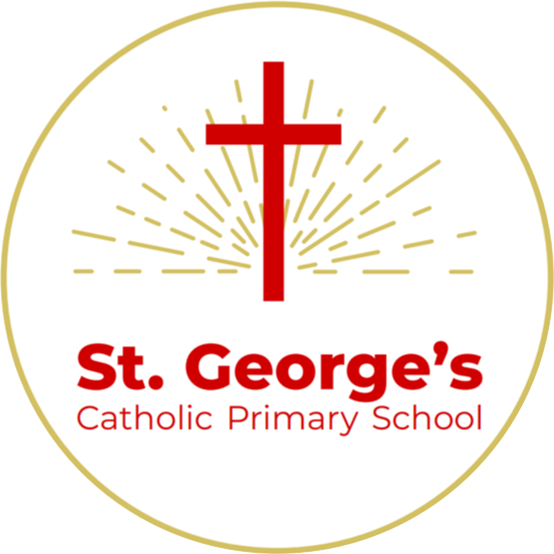PTA (Helping Hands)
Helping Hands at St.George's (PTA)
Welcome to the Helping Hands information page
Email: helpinghandsatstg@gmail.com
Instagram: helpinghandsatstgeorges
Facebook: St. George’s Parents Network
Our Parent - Teacher Association (PTA), known as the Helping Hands is a registered Charity (no. 1109877) and you consequently become a member of 'Helping Hands' when you join St George’s Catholic Primary School.
Our Mission
Our mission is to promote a community spirit, to raise much needed funds for our primary school, and to help make wonderful memories for every child that attends St George's.
Our school is under immense pressure to provide our children with equipment, facilities and enrichment activities to support their learning journey. That’s where we step in; to provide the ‘extras’ that our children need and enjoy!
We endeavour to set the best example for our children, by showing them that if we work as a team, act as a community, and support those in need, then we can achieve great things.
What we do
Our beautiful rosary garden, the play equipment in both the infant and junior playgrounds, and our school library were only possible due to the Helping Hands fundraising efforts. We work closely with the school Senior Leadership Team to support in the right places and have provided computers for every year group, funded new sensory equipment for younger years, upgraded furniture in our ICT suite, and provided an impressive selection of new books for all age groups.
Our children have wonderful memories of a Jubilee ‘school street party’, discos, a Happy circus, magical visits from Santa’s elves, a festive laser display, and an exciting King’s Coronation Party. Additionally, our Year 6 children always leave St George's with gifts to cherish, all made possible with Helping Hands funding.
With your support, projects like these are possible. Every penny that we raise goes towards enrichment activities or equipment for our children at school.
Our Committee
In March/ April each year, our Helping Hands committee formally meets for an AGM (Annual General Meeting) to elect 3 key roles: Chairperson, Deputy Chairperson, Treasurer. Volunteers tend to take up a role on the committee for 3 years and during this time you will organise specific events and fundraising activities.
Our current committee members:
- Christina Mannion-Grant (Chair)
- Rebecca Spranklen (Deputy Chair)
- Frank Suarez (Treasurer)
- Helen McGarrity (Secretary)
Supporting committee members:
Louise Atkin, Yara Somma, Emma Dodge, Romona Elliott, Linda MacPherson, Louise Mullan, Kerry Murphy-Okoluko
New members are always welcome!
How can you support Helping Hands?
Throughout the school year we invite families, friends, teachers and our local parish, to join together for fund-raising events, activities, and meetings that we host by contributing time, money, skills or advice.
We always need help, whether you have good local business contacts, can plan an event, have a great new idea, know how to rally support, or can stand at a table to sell an ice cream – your time is invaluable!
Our biggest events are the Summer and Winter Fayres which are lots of fun! But we also host regular smaller events including freeze pop Fridays, doughnuts for Dads, craft competitions, own clothes days, World Book day events, Easter activities. All these events need extra hands to help organise, promote, and carry through; we’re always looking for volunteers.
There are so many ways to get involved:
- Join the team as a committee member
- Join your ‘class link’ group. Every class has a WhatsApp group and your class link person will have direct communication with the Helping Hands to share information with you
- Become a regular volunteer, and help at small events. Join our ‘Extra Hands for Helping Hands’ WhatsApp group – either drop us an email or ask your class link to share your details with the Helping Hands committee and we’ll add you to Extra Hands
Become a business sponsor. If you’re a business owner, we would love to partner with you. Either drop us an email or ask your class link to share your details with the Helping Hands committee and we will get in contact to discuss how we can work together
Matched funding
If you work for an organisation with a matched funding policy (sometimes called a corporate social responsibility policy), any money you / we raise for the school could be matched by your employer. Companies may match the fundraising total for an event, or for the stall that their employee is working on. Please check with your company, let us know, and we’ll do the rest!
Company sponsored Volunteering Days
If you work for an organisation that has a Charity Volunteering Policy, you may be able to use these days to volunteer for the Helping Hands. We are a registered charity and you may be able to allocate your time to one of our events. Please check with your company and let us know if this might be possible.
Easy Fundraising – Sign up today!
More than 8000 retailers including M&S, Argos & Tesco participate in the Easy Fundraising scheme. Every time you shop online, they will donate a percentage of your total shopping cost to us at NO extra cost to you.
Sign up today https://join.easyfundraising.org.uk/stgeorgesrcps/
My Name Tags
My Name Tags produce name labels for children’s clothing and equipment, wall art & décor. Labels are available as personalised stickers, or iron-on labels. Every time you place an order through MyNametags, they will donate 24% of your purchase costs directly to Helping Hands.
Go to www.mynametags.com and always use the school ID at the checkout: 33586
Keep In Touch
Email: helpinghandsatstg@gmail.com
Instagram: helpinghandsatstgeorges
Facebook: St. George’s Parents Network
Our Summer Fayre 2019

.jpg)








.jpg)